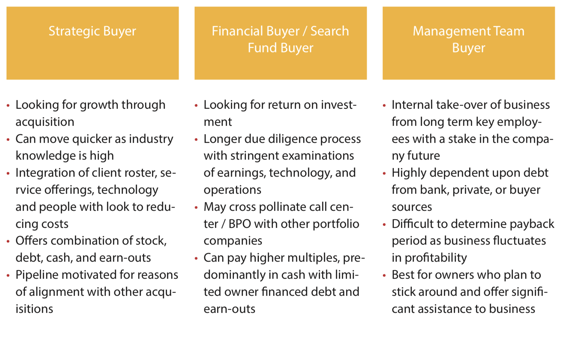The Exit Strategy Explained

Designed to result in a positive exit experience.
Writing an exit strategy is only effective if it centers around the owner’s goals. From determining how long the owner will stay on during transition to factoring in how key employees will be treated after the exit, plans must be developed long before marketing the company. Much of the planning involves identifying which type of buyer is right for your company. If you could pick out a buyer for your rm today, who would it be and why? This is a vital component to the exit process. There are many types of buyers, but we see these 4 key players in the market today:
- Strategic Buyer: Another call center / BPO
- Financial Buyer: Private Equity, Independent Sponsors
- Search Fund Buyer: A form of Private Equity, very limited in scope
- Management Team Buyer: Internal team members

Exit Planning and Explanation
Each buyer has their own strengths and weaknesses, but they are very different to deal with
in terms of types of exits, negotiations, and due diligence requirements. Matching the correct
buyer type to the opportunity allows the owner to understand how his or her exit goals will be accomplished. For example, Strategic Buyers may offer stock as part of the sales price which allows for potential upside but limits the cash received upon close. Financial Buyers offer more cash but may demand a seller note or earn out for as much as 30% of the purchase price. Seed Capital, or Search Fund Buyers are very interesting to retiring owners who want to leave the business, its name and the management team intact. Management Team Buyouts are wonderful instruments but add a layer of risk to both sides that must be understood before entertaining them.

Examining the types of exit instruments used, the following are typical in a sale: cash, stock, earn-outs, and buyer notes. Most sales will have a combination of at least two, and as many
as three types of renumeration for the seller. Cash is king, and up front is best. The strongest,
more pro table, and highest growing call centers get more cash at close. However, in unique circumstances (health issues, accelerated retirement, etc), cash can be available in lieu of a loan or earn out. Stock can be a great way to get a second bite at the apple as the acquiring company looks to exit downstream. The type of stock received is important, as some types are more liquid than others. Earn-outs and seller notes come in all shapes and sizes, but when matched up with an owner’s goals, many lead to a very acceptable asset.
One key question regarding the exit, is whether the owner wants to stay on for a period of time or hand over the keys directly at the close? Depending on that answer, the buyer profile would have to be changed accordingly in order to suit the owner’s exit goals. Of course, there are tax implications and strategies that need to be employed with every exit, and from time to time, when real estate is involved, that needs to be factored into the equation as well.
Identifying the right buyer through an exit strategy plan will lead to a far better exit experience and an overall higher price point each and every time -- whether an owner wants to retire, be a part of a larger organization, consolidate due to financial hardship, or simply get out of the business.


